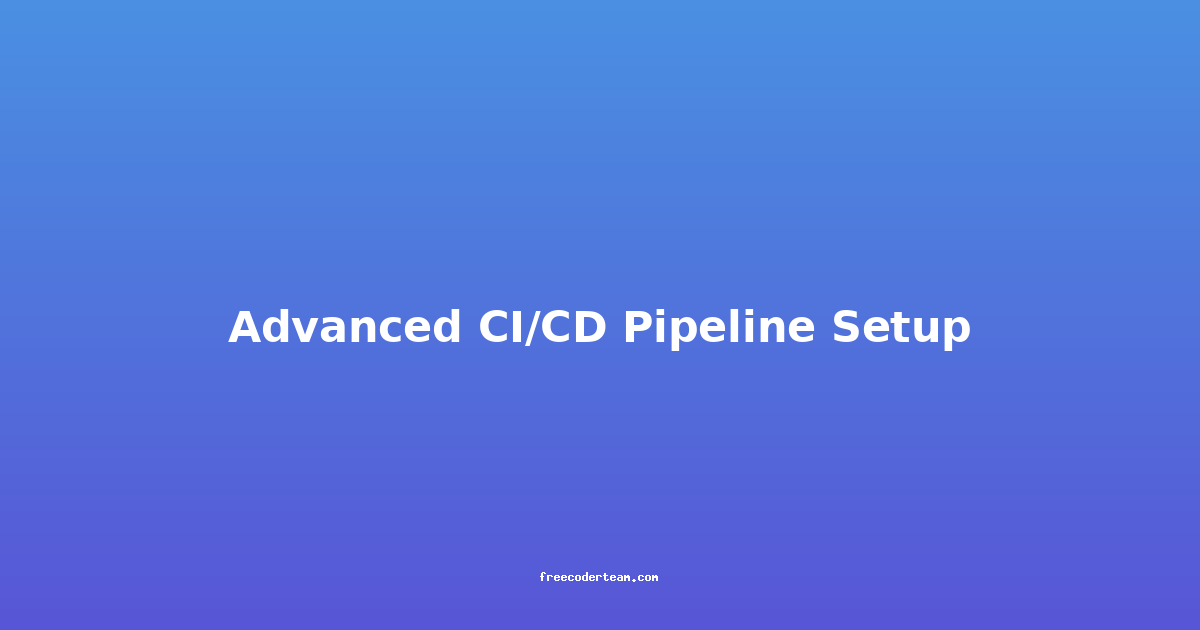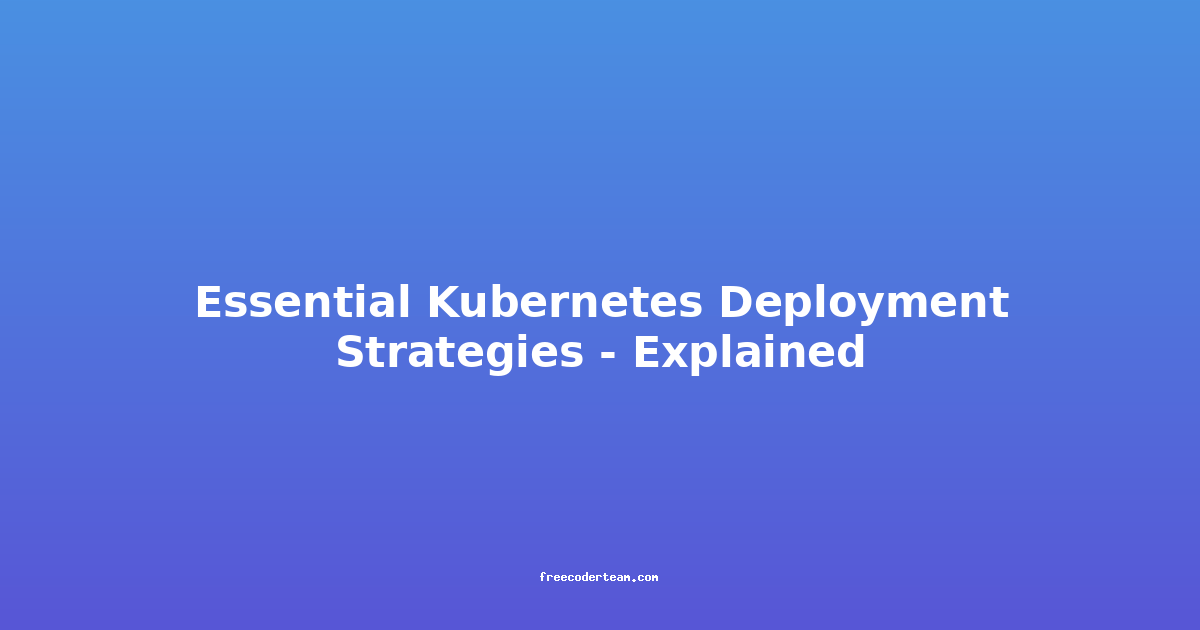Advanced CI/CD Pipeline Setup: Best Practices and Practical Insights
Continuous Integration/Continuous Deployment (CI/CD) pipelines are the backbone of modern software development, enabling teams to deliver high-quality code faster and more reliably. A well-designed CI/CD pipeline ensures that code changes are automatically tested, built, and deployed to production with minimal human intervention. In this blog post, we'll explore advanced CI/CD pipeline setup, focusing on best practices, practical examples, and actionable insights.
Table of Contents
- Understanding CI/CD
- Key Components of a CI/CD Pipeline
- Best Practices for CI/CD Pipelines
- Practical Example: Setting Up a CI/CD Pipeline
- Actionable Insights
- Conclusion
1. Understanding CI/CD
CI/CD is a software development practice that automates the process of integrating, testing, and deploying code changes. The pipeline consists of a series of steps that ensure code quality, security, and reliability. By automating these processes, teams can reduce manual errors, increase efficiency, and deliver updates more frequently.
- Continuous Integration (CI): Focuses on automating the integration of code changes into a shared repository. This ensures that code changes are tested immediately, allowing developers to catch issues early.
- Continuous Deployment (CD): Automates the deployment of code changes to production, ensuring that tested and approved code is pushed to live environments without manual intervention.
2. Key Components of a CI/CD Pipeline
A robust CI/CD pipeline typically includes the following components:
2.1. Version Control System (VCS)
- Purpose: Manages code changes and ensures version history is maintained.
- Tools: Git, SVN, Mercurial.
- Best Practice: Use feature branches for development and merge changes into the main branch only after successful testing.
2.2. Build and Test Stage
- Purpose: Automates the building and testing of code changes.
- Tools: Jenkins, CircleCI, GitHub Actions, GitLab CI/CD.
- Best Practice: Implement unit tests, integration tests, and static code analysis to catch issues early.
2.3. Deployment Stage
- Purpose: Automates the deployment of code changes to production.
- Tools: Kubernetes, AWS CodeDeploy, Helm.
- Best Practice: Use infrastructure-as-code (IaC) tools like Terraform or Ansible to manage infrastructure.
2.4. Monitoring and Feedback
- Purpose: Monitors the deployed application and provides feedback on performance and issues.
- Tools: Prometheus, Grafana, ELK Stack.
- Best Practice: Set up alerts for anomalies and integrate feedback into the pipeline for continuous improvement.
3. Best Practices for CI/CD Pipelines
3.1. Keep Pipelines Fast and Reliable
- Reduce Build Time: Optimize build scripts and use caching to speed up builds.
- Parallelize Tasks: Run tests and builds in parallel to reduce pipeline execution time.
3.2. Automate Everything
- Automate Tests: Ensure all automated tests pass before deploying.
- Automate Deployment: Use scripts or tools to automate the deployment process.
3.3. Use Infrastructure as Code (IaC)
- Benefits: Ensures consistency, simplifies scaling, and reduces human error.
- Tools: Terraform, Ansible, AWS CloudFormation.
3.4. Implement Security Checks
- Static Code Analysis: Use tools like SonarQube to identify security vulnerabilities.
- Dependency Scanning: Ensure dependencies are up-to-date and secure.
3.5. Monitor and Log
- Metrics: Track pipeline performance, test results, and deployment success rates.
- Logging: Capture detailed logs for debugging and troubleshooting.
4. Practical Example: Setting Up a CI/CD Pipeline
Let's walk through a practical example of setting up a CI/CD pipeline using GitHub Actions, a popular CI/CD tool integrated with GitHub.
4.1. Scenario
We have a Python web application that we want to deploy to a Kubernetes cluster. The pipeline will:
- Build the application.
- Run tests.
- Build a Docker image.
- Push the image to a container registry.
- Deploy the application to a Kubernetes cluster.
4.2. Steps
Step 1: Configure the GitHub Repository
Create a .github/workflows/main.yml file in your repository to define the pipeline.
name: CI/CD Pipeline
on:
push:
branches:
- main
jobs:
build-and-test:
runs-on: ubuntu-latest
steps:
- name: Checkout code
uses: actions/checkout@v3
- name: Set up Python
uses: actions/setup-python@v4
with:
python-version: '3.9'
- name: Install dependencies
run: |
python -m pip install --upgrade pip
pip install -r requirements.txt
- name: Run tests
run: |
pytest
deploy:
needs: build-and-test
runs-on: ubuntu-latest
steps:
- name: Checkout code
uses: actions/checkout@v3
- name: Set up Docker Buildx
uses: docker/setup-buildx-action@v2
- name: Login to Docker Hub
uses: docker/login-action@v2
with:
username: ${{ secrets.DOCKER_HUB_USERNAME }}
password: ${{ secrets.DOCKER_HUB_PASSWORD }}
- name: Build and push Docker image
uses: docker/build-push-action@v3
with:
context: .
file: Dockerfile
tags: myapp:v1
push: true
- name: Deploy to Kubernetes
run: |
kubectl apply -f k8s/deployment.yaml
Step 2: Breakdown of the Workflow
-
Build and Test:
- The
build-and-testjob runs on Ubuntu and installs Python dependencies, runs tests, and ensures the code is stable. - The
pytestcommand runs unit and integration tests.
- The
-
Deploy:
- The
deployjob depends on thebuild-and-testjob and builds a Docker image. - It logs into Docker Hub using secrets stored in GitHub.
- The Docker image is pushed to Docker Hub.
- Finally, the application is deployed to a Kubernetes cluster using
kubectl.
- The
Step 3: Configure Secrets
In GitHub, store sensitive information like Docker Hub credentials as repository secrets:
- Go to Settings > Secrets > Actions.
- Add
DOCKER_HUB_USERNAMEandDOCKER_HUB_PASSWORD.
5. Actionable Insights
5.1. Start Small, Scale Up
Begin with a simple pipeline that automates basic tasks like building and testing. As you gain confidence, add more complex steps like containerization and deployment.
5.2. Use Environment Variables
Store sensitive information like API keys and database credentials as environment variables or secrets. Avoid hardcoding sensitive data in your code or configuration files.
5.3. Leverage Cloud Providers
Cloud providers like AWS, Google Cloud, and Azure offer robust CI/CD tools (e.g., AWS CodePipeline, Google Cloud Build) that integrate seamlessly with their infrastructure.
5.4. Monitor Pipeline Health
Use monitoring tools to track pipeline performance and identify bottlenecks. Tools like Grafana or Prometheus can help visualize metrics like build time, test coverage, and deployment success rates.
5.5. Practice Continuous Learning
Stay updated with the latest CI/CD tools and best practices. Tools like GitHub Actions, Jenkins, and CircleCI are constantly evolving, and learning new features can help optimize your pipeline.
6. Conclusion
Advanced CI/CD pipeline setup is essential for modern software development. By automating the build, test, and deployment processes, teams can deliver high-quality software faster and more reliably. This blog post covered key components, best practices, and a practical example using GitHub Actions.
Remember, the goal of a CI/CD pipeline is not just automation but also to ensure that every code change is thoroughly tested and deployed with minimal risk. By following best practices and continuously improving your pipeline, you can achieve faster time-to-market and higher customer satisfaction.
Call to Action
- Experiment with GitHub Actions: Try setting up a simple CI/CD pipeline for one of your projects.
- Optimize Existing Pipelines: Review your current pipeline and identify areas for improvement.
- Share Your Experience: Discuss your CI/CD setup with your team and share insights for continuous improvement.
By implementing these practices, you can build a robust CI/CD pipeline that supports your development process and helps you deliver software faster and more reliably.




